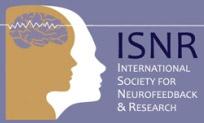- ADHD Neurofeedback Study for 7-10 year old Children
Please click HERE for more information about our current NIMH-funded study.
- About Neurofeedback
Neurofeedback (also known as Brainwave Biofeedback or EEG Biofeedback) is a non-medication treatment alternative for ADHD and other neurobiologically based difficulties. The first published studies started appearing in the 1970’s. Advances in neuroscience and technology have resulted in increased research and clinical work each year.
The problem is EEG dysregulation: brainwaves that are too slow or too fast.
Our brains are continually discharging electrical activity at different speeds and power at different brain locations. Slower brainwaves are made when sleeping or daydreaming. When we are concentrating our brainwaves are faster. Individuals with ADD/ADHD often make more slow brainwaves in comparison to non-ADD individuals. Overanxious individuals may have brainwaves that are excessively fast. Individuals with acquired brain injury, autistic spectrum disorder, and brain-based depression often have predictable EEG patterns. Neurofeedback helps individuals modify their brainwave patterns.
After neurofeedback training, individuals show clear and lasting gains in their symptoms. For example, ADHD individuals typically focus better, are less distractible and less impulsive. Many also show gains in other areas (e.g. sleep, emotional regulation and social functioning. They are often able to maintain these gains without medication or with less medication(s).We train the brain to make more of some brainwaves while decreasing other types of brainwaves. This helps the brain become more efficient.
After neurofeedback training, individuals show clear and lasting gains in their symptoms. For example, ADHD individuals typically focus better, are less distractible and less impulsive. Many also show gains in other areas (e.g. sleep, emotional regulation and social functioning. They are often able to maintain these gains without medication or with less medication(s). Researchers attribute these gains to the brain functioning in a more efficient and stable manner, with some researchers attributing that to improvements in cerebral blood flow.
- Brainwaves
Brainwaves are characterized by their speed in Hertz, the number of brainwaves made in a second. We make a variety of waves all the time, but some tend to be more prevalent moment to moment.
Neurofeedback involves increasing some types of brainwaves while decreasing others. Often we are decreasing delta, theta and alpha while increasing low beta and beta.Delta 1-4 Hz. sleepy, foggy Theta 4-7 Hz. internal focus, spacey Alpha 8-11 Hz. relaxed, autopilot Low Beta 12-15 Hz. calm focus Beta 15-20 Hz. alert focus Hi Beta 20-36 Hz. hyperaroused, anxious We want our brains to make the right brain waves at the right times depending on our goal.
- Clinical Populations
The initial utlization of neurofeedback was for treatment resistant seizure disorders and later ADHD. There is supportive research for both of those populations.
Additional clinical populations have been successfully treated with neurofeedback, such as autism, acquired brain injury, mood and anxiety disorders, and pain disorders. Additional research is underway.
The Research section below contains a link to various websites and a very comprehensive bibliography which has links to research about many disorders . Neurofeedback has also been used for peak performance training by professional athletes, Olympians, musicians, singers and executives.
- Medications
Medication decisions should be made by you and your physician. Neurofeedback often helps invidividuals reduce or eliminate their medications.
Many patients start neurofeedback while on medication(s), and then we collaborate in helping their physician adjust the doseage down. We can train while on medication without difficulty, although some medications may slow down the training process. If a brain map (Quantitative EEG) is done, we prefer to do that off medication if possible, recognizing that some patients can not safely go off of their medications for even a couple of days.
If a patient is considering starting neurofeedback while also starting medication, we recommend that they either start the neurofeedback without medication or start medication first prior to the neurofeedback so we can isolate which treatment is doing what.
- Training Sessions
What happens in a session?
We start the session with getting updated of the progress toward the training goals that have been set.
One or two sensors are placed on the scalp and ears. There is no breaking of the skin or any discomfort.
The sensors are like little stethoscopes which “listen in” and feed the brainwaves into an amplifier (an Electroencephalogram machine) that is linked to a computer. The brainwaves are converted into video and audio displays. By watching the screen and listening to tones, the individual is given immediate feedback that tells whether his/her brain is making faster or slower brainwaves moment to moment.
The feedback displays may be simple games (e.g. pacman, or keep one rocket ship ahead of the other). DVD feedback may also be used with children and adolescents to enhance motivation. The feedback monitor would show a DVD playing with blinds covering the screen. When the desired brainwave patterns are made the DVD is seen clearly and when the inefficient brainwave patterns are made the blinds begin to close.
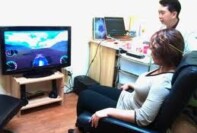
By practicing controlling the displays, individuals learn to produce brainwaves that are normally present when they are calm, still and well focused. ADHD individuals can learn what it feels like when relaxed and concentrating. Anxious individuals can learn what it feels like when their brain is calm.
We typically schedule an hour for traditional neurofeedback training sessions, with about 20-30 minutes of actual training, dependent upon the individual’s needs.
- Brain Mapping
Quantitative Electroencephalogram (QEEG), also known as a Brain Map is a diagnostic technique that has benefits for neurofeedback. An elastic net cap with 19 sensors is placed on the head so that the brainwave activity can be measured. There is no piercing of the skin. Brainwaves are then recorded with eyes closed and again with eyes open. This data is then compared to one or more normative databases. This results in a series of tables and graphs which indicate which areas have brainwave abnormalities, the degree of abnormality, and the brainwave frequencies that are involved. This leads to specific neurofeedback protocols. The benefit of doing a QEEG is that it may reduce the number of neurofeedback sessions and increase the effectiveness of treatment.
Brain maps guide efficient and effective treatment by guiding where the sensors should be placed and what frequencies should be addressed in training.
Understanding the numbers and graphics
The numbers generated are Z scores which is a metric which represents how normal or abnormal a score is in comparison to the Neuroguide Database. A Z score of +1 represents a score exceeding 84% of individuals that age; +1.25 exceeds 89%; +1.5 exceeds 93%; +2.0 exceeds 98%.
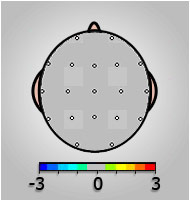
A combination of tables and graphics of Z scores appear below for either the traditional EEG bands (e.g. Delta 1-4 Hz.; Theta 4-8 Hz.; Alpha 8-12 Hz., Beta 12-25 Hz, etc.) or for specific single Hz bins to enable increased precision.
The heads use colors to represent the Z scores at the 19 sites, with the nose on the top. Grey represents scores that are normal (+/- 1 Z score). The dots on the head are electrode sites (e.g. the top two being prefrontal sites).
Here is an example of three seconds of EEG recorded at 19 sites which shows the brain making normal brainwaves to start but then shifts into a dysregulated state where it makes the larger, slower brainwaves (theta). This dysregulated state is likely occurring when this ADHD child is inattentive.
ADHD child’s EEG (8yrs old)
When this child’s recorded brainwaves are averaged and compared to a database we find that he is making more theta activity in the frontal and prefrontal sites is greater than 97% of children his age. This information can be represented in graphs as seen below.
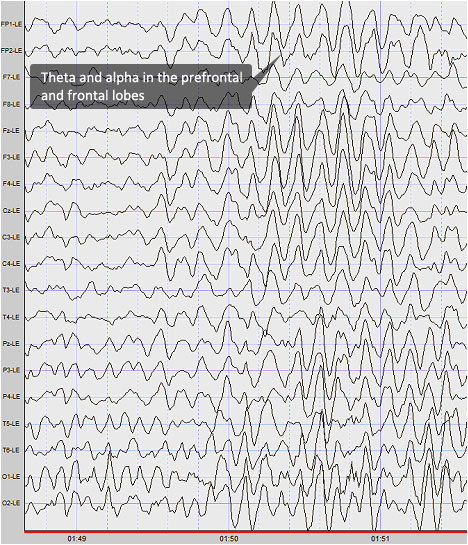
Same ADHD child’s EEG represented graphically
We can see his excessive theta activity in the graph below:
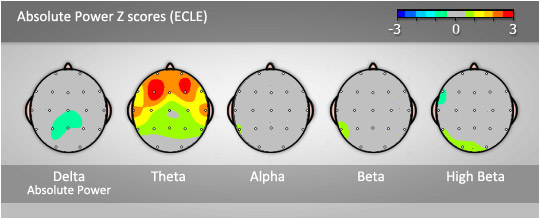
Adult with Obsessive Compulsive Disorder
An adult suffering with severe Obsessive Compulsive Disorder has a QEEG which shows very excessive fast wave activity, a common pattern in OCD:
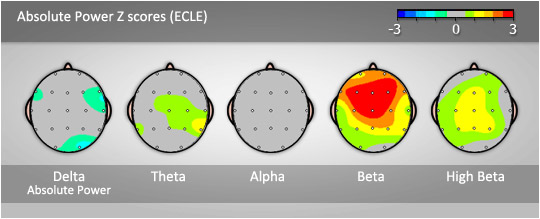
Adolescent with Seizure Disorder
An adolescent with a severe seizure disorder (5x/week) had this QEEG before and after treatment:
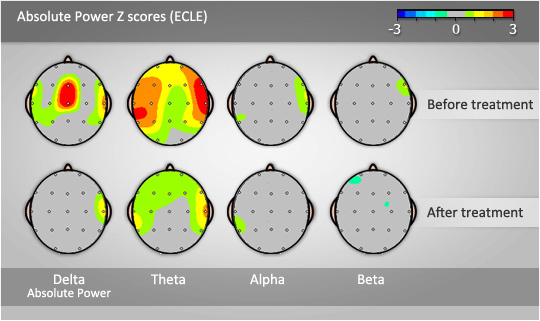
After a course of neurofeedback, you can see he had a much improved QEEG (and only one seizure in 3 months). Notice the significant reduction of Delta and Theta activity.
Connectivity: A measure of how the various parts of the brain communicate with each other
Brainmaps provide a great deal of additional information in a variety of tables and graphs. In addition to measures of the power of the EEG at various speeds, the Connectivity measures give information about but about how well one part of the brain is communicating with another part of the brain.
This adolescent with ADHD and Obsessive Compulsive Disorder has difficulties with effective communication between various prefrontal and frontal lobe sites.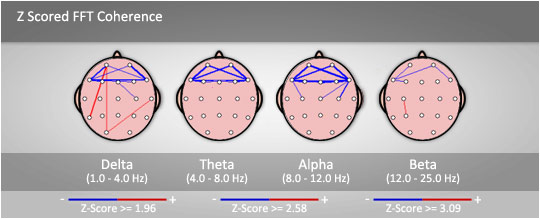
- Research
A good starting point is to read: What is Neurofeedback?
A very comprehensive bibliography which has links to research about many disorders is available through the International Society for Neurofeedback and Research: http://www.isnr.org/resources/ComprehensiveBibliography.cfm
A Meta-Analysis of The Efficacy of Neurofeedback in ADHD in the Journal of Clinical EEG and Neuroscience (July 2009) noted:
Meta-Analysis on Neurofeedback for ADHD“…we conclude that neurofeedback treatment for ADHD can be considered “Efficacious and Specific (Level 5) with a high effect size for inattention and impulsivity and a medium effect size for hyperactivity.” > View the article hereSome of the better websites are:
- The major professional organization: www.isnr.org
- A company which provides training for professionals: www.eegspectrum.com
- Another company which provides professional training: www.eeginfo.com
- This is a rich site: www.AboutNeurofeedback.com

